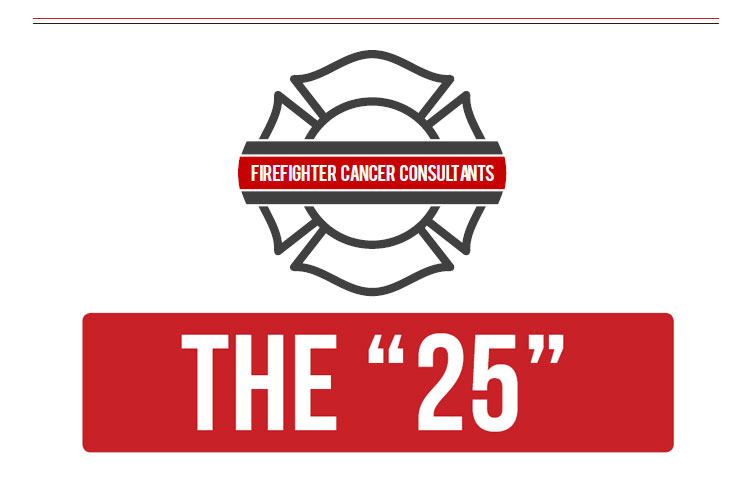

By Jim Burneka Jr.
Research regarding cancer in firefighters has made considerable headway in the past few years. The fire service has gained a better understanding of how firefighters are being exposed to harmful chemicals and carcinogens, as well as learning how to implement new corresponding preventive techniques.
RELATED: Construction Concerns: Soot and Cancer | Occupational Cancer and the Fire Service | Fire Service Occupational Cancer: The Elephant in the Room | When Cancer Strikes in Your Department
Many fire departments across the country have begun working on their cancer preventive initiatives. Some fire departments recognize the need for change but aren’t quite sure where to start. “The 25” checklist was created with the intent of assisting departments in evaluating their current practices compared to the best practices on reducing the risk of receiving an occupational cancer diagnosis. This article should be used as a resource on how to assess and implement firefighter occupational cancer preventive measures throughout your department.
Assessment
To properly address the current state of a department regarding cancer prevention, departments should complete a self-examination that compares their current practices with best practices for reducing their risk of being diagnosed with cancer. “The 25” checklist is a great assessment tool that allows departments to understand where they currently stand and what items need attention. It is recommended that each department create a Health and Safety Cancer Committee that can work together on the assessment and implementation of preventative techniques.
Training
The main priority should be training fellow firefighters about how significant a threat occupational cancer is. Department members will be more supportive about procedural and cultural changes if they have been educated beforehand on why this change is necessary for the betterment of their lives and their families.
The firefighter cancer training should consist of firefighter cancer awareness, prevention, and support. There are a multitude of training options available throughout the country. Any chance to make these trainings personal to the members will also increase buy-in. Having firefighter cancer survivors talk or sharing the legacy of members who have succumbed to this epidemic personalizes the training and could influence current members to take this topic seriously.
Low-Hanging Fruit
An unfortunate trend throughout the fire service is that many departments prioritize items based on finances, not safety. To avoid this pitfall when it comes to firefighter cancer, aim for the low-hanging fruit, at least at first. Try to implement the items that cost little or nothing and are logistically easy to implement. Once this is completed you should have a good base to build on and grab those high-hanging fruits later. The low -ganging fruits on “The 25” checklist include:
- Wear self-contained breathing apparatus (SCBA) and full personal protective equipment (PPE) on all structure, car, and trash fires.
- Engineers and command staff should wear SCBA and full PPE in proximity to the fire.
- Investigators and command should wear SCBA and full PPE while inside the structure.
- Use wipes on scene to remove contaminants on the skin.
- Wash hands before ingesting foods or liquids while on scene.
- Gross decon PPE while on scene (see video below).
- Transport PPE, SCBA, and tools outside the cab, if possible.
- Clean contaminated SCBA, tools, and hose back at the fire station.
- Shower ASAP, ideally out of service.
- Change and wash contaminated clothing at the fire station.
- Wash PPE ASAP, including your helmet, hood, gloves and boots.
- Switch into backup set of PPE ASAP.
- Keep PPE in totes if transporting in personal or department vehicles.
- PPE should never go inside the fire station’s living quarters.
- Avoid storing frequently used items in compartments directly over the diesel exhaust tip.
- Keep living quarters door shut.
- Exercise and eat healthy.
- Use sunscreen and wear a hat.
- Keep documentation of exposures from fire calls.
- Avoid all tobacco products.
High-Hanging Fruit
After you build your foundation, you can start working on the high-hanging fruit items. The majority of these items cost a significant amount and may have to be budgeted with capital funds or paid for with grants. These items may also be logistically difficult to implement due to lack of resources or cultural pushback. The high-hanging fruits on “The 25” checklist include:
- Wear SCBA and full PPE throughout the duration of overhaul.
- Upgrade PPE with new particulate-blocking technology.
- Avoid storing PPE in the apparatus bay.
- Use diesel exhaust systems as recommended.
- Conduct annual medical and skin exams.
Download the PDF HERE.
*
The preventative measures recommended above will not be something that can be completed overnight. These measures are a part of a process that can be drawn out over the span of years. This new way of thinking does not come naturally to a majority of firefighters, so do not become discouraged if everyone is not initially supporting these changes. Eventually they will realize these measures are saving their lives, one step at a time.
Jim Burneka Jr. is the founder of the Firefighter Cancer Consultants, LLC. Jim has been involved in the fight against firefighter occupational Cancer for more than a decade. More at firefightercancerconsultants.com.
MORE
Reducing the Postfire Threat of Cancer
Creating a Cancer-Resistant Fire Department

